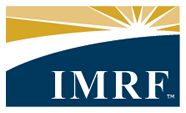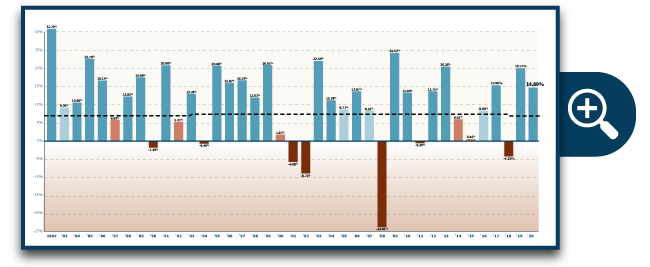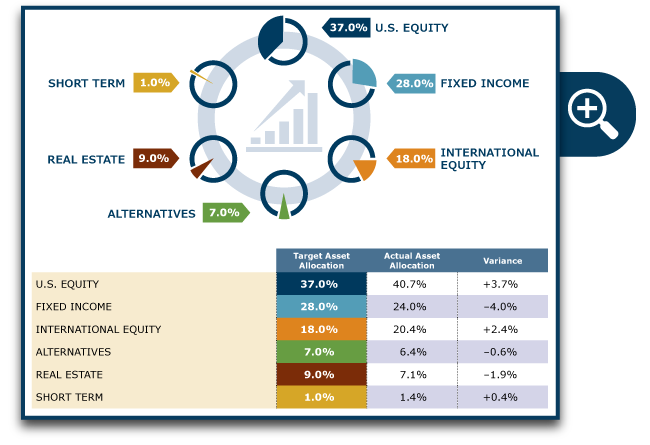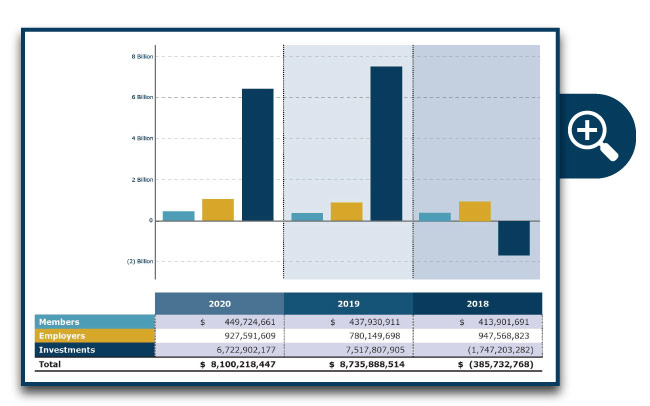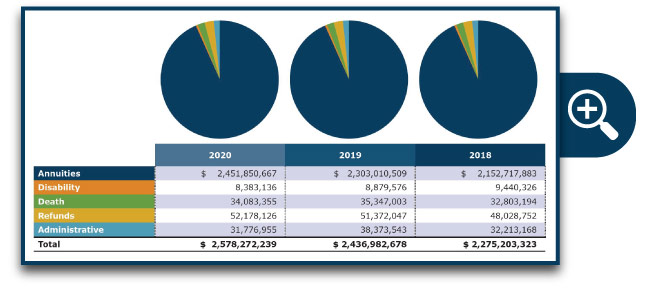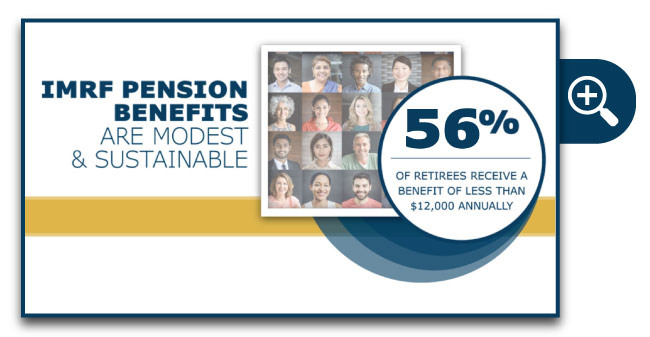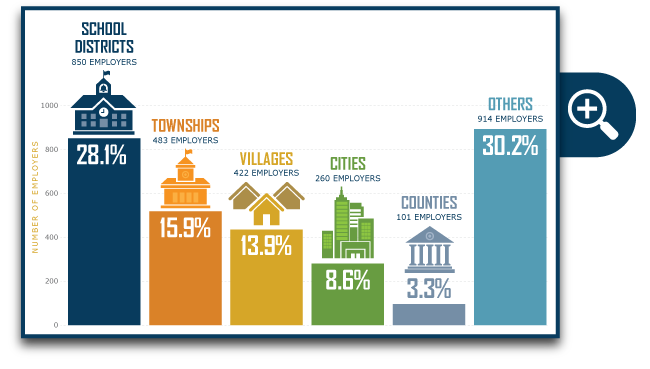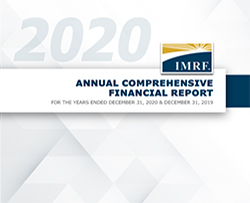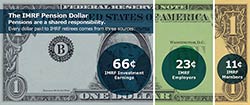IMRF invites you to read our 2020 Popular Annual Financial Report (PAFR). Derived from IMRF’s 2020 Annual Comprehensive Financial Report (ACFR), the PAFR is consistent with generally accepted accounting principles (GAAP) and shares a summary of our financial condition, highlighting key insights in five sections. Further details can be found in the ACFR. Click the links below to navigate to each section of our 2020 PAFR.
Fiduciary Net Position
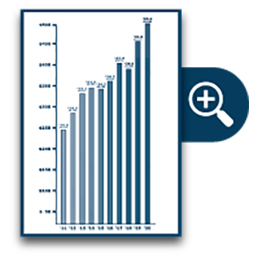
IMRF's fiduciary net position—total assets and deferred outflow of resources minus liabilities and deferred inflow of resources—was $50.6 billion as of December 31, 2020. That was an increase of $5.5 billion, or about 12.3%, from 2019. The increase is attributable to strong 2020 investment returns. The 2020 financial markets remained strong and vastly rebounded from the losses in the beginning of 2020 boosted mostly from an improving economy and adapting to the impact of the pandemic.
Over the last 10 years, IMRF’s fiduciary net position has grown 104% - an addition of $25.7 billion.
Funding Status
IMRF's funding status is a key indicator of our overall financial health. It reflects the percentage of benefit promises that IMRF has assets to pay. IMRF strives toward 100% funding because it guarantees that the system can meet its obligations and is most cost effective for taxpayers.
As of December 31, 2020, IMRF was 94.1% funded on an actuarial basis. IMRF's actuarial funding status is determined by independent actuaries using a "smoothing" technique that recognizes investment gains and losses over a five-year period. The actuarial funding status is used to set IMRF contribution rates for participating units of government. Below you will see that over the last 10 years IMRF's funded status has held strong above 85% dating back to 2013.
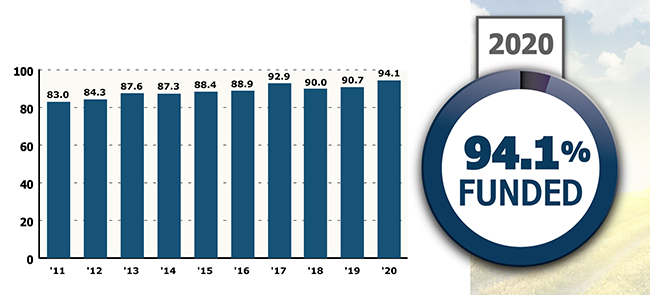
Investments
IMRF’s investment portfolio was valued at $50.3 billion on December 31, 2020.
The portfolio returned 14.79% after investment management fees during 2020. This return increased the value of the portfolio by $5.5 billion from December 31, 2019.
Global stocks marched steadily upward in 2020. Investor confidence in continued global economic growth helped all major asset classes post positive returns.
IMRF’s U.S. Stock portfolio performed particularly well during 2020 recording 21.9% return. The international stock portfolio returned 13.1% compared to 10.7% for IMRF's benchmark.
IMRF’s current long-term goal is to earn an annualized total fund return of 7.25%, after investment-management fees. With a return of 14.79% in 2020, IMRF achieved its goal. IMRF has also achieved its investment return goal over longer time horizons. For example, over the last 5 years, IMRF has earned 8.9% after paying investment-management fees. The bar chart below shows IMRF’s returns over the past 39 years compared to our assumed rate of return.
2020 Target vs. Actual Asset Allocation
The IMRF Board of Trustees maintained the same target asset allocation for the IMRF investment portfolio in 2020 as for 2019. The target allocation has two key goals: maximize return and minimize risk. The Board continually evaluates the portfolio’s target asset allocation and makes adjustments as necessary.
As the value of the assets fluctuates, the portfolio’s actual allocation always varies from the target. The goal is for the actual allocation to be within 4% of the target within each asset class.
On December 31, 2020, the portfolio’s actual allocation was within the prescribed range for all asset classes.
Revenue and Expenses
Revenue
IMRF’s revenue comes from member contributions, contributions from participating units of government (also called IMRF employers), and investment income. IMRF’s total revenue during 2020 was $8.1 billion.
About 98% of IMRF members participate in the Regular Plan. These members pay 4.5% out of every paycheck to fund IMRF benefits. Total member contributions were almost $450 million in 2020.
All IMRF employers also make monthly payments to support the IMRF benefit system. Each IMRF employer pays an amount calculated by IMRF based on its IMRF assets, liabilities, and the demographics of its workforce. Total employer contributions were $928 million in 2020.
Member and employer contributions are invested. Historically, IMRF investments account for the majority of IMRF’s revenue. This was true in 2020, when IMRF investments generated $6.7 billion in revenue.
As you can see from the 3 year comparison below member and employer contributions remain stable while investment returns are strong but volatile.
Expenses
IMRF's expenses include annuities (pension payments), disability and death benefits, refunds to members, and the cost to administer IMRF’s benefit system. In 2020, IMRF’s total expenses equaled about $2.6 billion.
Total expenses increased by about $141 million from 2019 to 2020, or about 5.8%.
Members and Employers
IMRF experienced growth in both members and employers in 2020.
Members
Members increased by 3.1% over the last three years to a total of 442,843 active members, inactive members, and retirees in 2020.
| Members | 2020 | 2019 | 2018 |
|---|---|---|---|
| Active | 170,735 | 177,809 | 176,517 |
| Inactive | 129,779 | 124,170 | 119,939 |
| Retirees | 142,329 | 138,089 | 133,261 |
| Grand Total | 442,843 | 440,068 | 429,717 |
The typical IMRF retiree receives a modest benefit, earned after decades of public service. In 2020, out of IMRF’s 142,324 retirees, less than 2.4% of retirees receive $72,000 or more annually.
Distribution of Annuitants by Pension Amount
| Annual Pension Amount | Annuitants |
|---|---|
| Under $1,200 | 6,266 |
| $1,200 to under $3,000 | 14,809 |
| $3,000 to under $6,000 | 24,574 |
| $6,000 to under $9,000 | 18,847 |
| $9,000 to under $12,000 | 14,039 |
| $12,000 to under $24,000 | 31,078 |
| $24,000 to under $36,000 | 14,071 |
| $36,000 to under $48,000 | 7,581 |
| $48,000 to under $60,000 | 4,358 |
| $60,000 to under $72,000 | 2,513 |
| $72,000 and over | 3,357 |
Employers
The Illinois Pension Code specifies the units of government required to participate in IMRF and those that may elect to join. In 2020, 3,031 units of government (employers) participated in IMRF, compared to 2,964 in 2011.
| Calendar Year End | Cities | Villages | Counties | School Districts | Townships | Other | Total |
|---|---|---|---|---|---|---|---|
| 2020 | 261 | 422 | 101 | 850 | 483 | 914 | 3,031 |
| 2011 | 257 | 411 | 101 | 862 | 479 | 854 | 2,964 |
